| 1 | Tiger ratsnake |
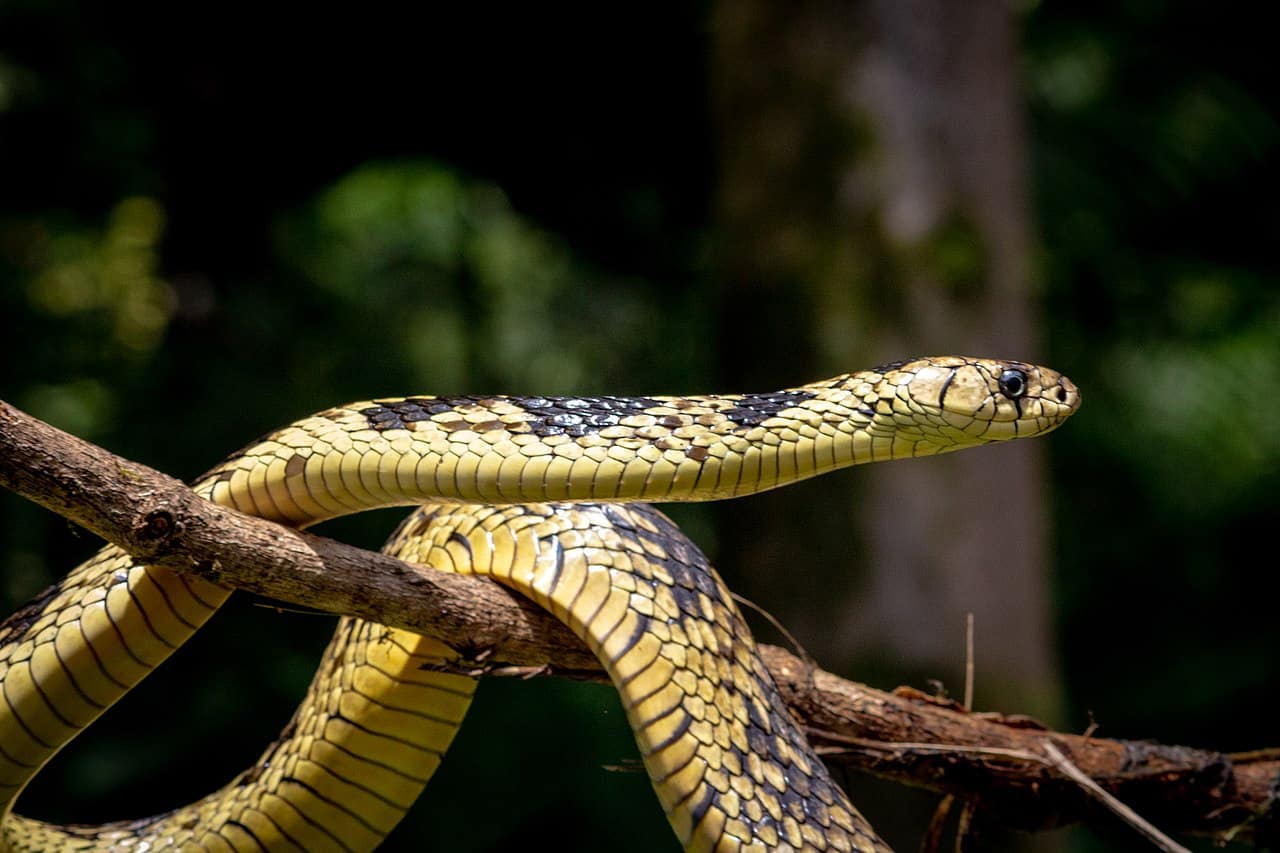
A South American constrictor which few westerners have heard of, but is secretly one of the continent’s most widespread snakes, alongside the boa constrictor. The tiger ratsnake (Spilotes pullatus) ranges from eastern Mexico in the north to Paraguay in the far south. This is also one of the largest snakes in South America. At a maximum length of 2.7 metres, the tiger ratsnake is larger than every single US ratsnake, proving the rule that everything grows to be freakier and more monstrous in jungles.
The tiger ratsnake inhabits warmer regions and climbs trees with ease, while also moving along the ground. Like most ratsnakes, they’re non-venomous, but have an aggressive reputation. This species is a constrictor which either asphyxiates its prey in coils, or presses them firmly against a wall.
In January 2001, a sighting from an ecological reserve on Brazil’s Atlantic coast added bats to its diet. The 215cm tiger ratsnake had crawled into a house roof, and was lurking approximately 2 metres away from a roosting bat colony. When the scientists approached, they noticed a bat-shaped bulge in the snake’s stomach.
3 months later, another tiger ratsnake was spotted slithering into the exact same roof. Another study found a bat from the Molossus group in a tiger ratsnake’s stomach. The bat was too digested for the exact species to be identified, but those confirmed in their diet elsewhere include black mastiff bats and Jamaican fruit bats.
| 2 | Blanding’s cat snake |
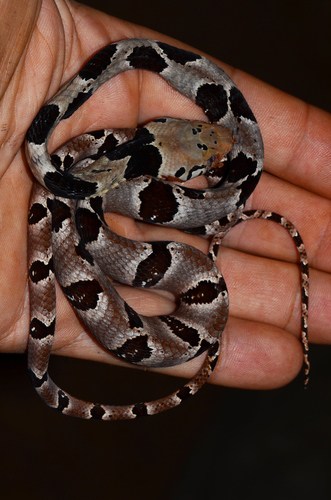
This little known African snake reaches 2.8 metres, and is neither venomous nor a constrictor. Blanding’s catsnake (Toxicodryas blandingii) consumes its prey using sheer willpower, manipulating its catch with its coils and then swallowing them down.
Blanding’s catsnakes are a central to west African species, and are especially common in Nigeria, where thatched roofs are one of their favourite hangouts. Like the tiger ratsnake, this African species climbs trees with ease, and was once spotted 25 metres high in a Nigerian palm oil plantation. They put these skills to good use, by using the bat kingdom as a convenient calorie source.
One snake measuring 1.8 metres from Sierra Leone had 8 bats in its stomach, including the white-winged serotine bat. In Guinea, one of their favourites is the Angolan free-tailed bat. Another Blanding’s catsnake was spotted in a cave in Gabon, where a huge bat colony was lurking.
It’s guaranteed that many epic duels unfold in the wild which we’re completely unaware of. In one sighting, a Blanding’s catsnake randomly fell from the roof of a golf club 3 metres high. As it hit the ground, a bat colony above let out a loud chorus of excited peeping, probably because they’d just defeated their arch enemy.
| 3 | Cuban boa |

One of the longest snakes of all, with a supposed maximum length of 6.4 metres, and rumours of even 8 metres back in the early Colonial period.
Alongside the Puerto Rican boa, the Cuban boa has by far the most bat-munching sightings to its name. It’s the only large boa found on the island of Cuba, and is most common within forest areas. Search hard within those forests, and you’ll find dark, dripping limestone caves, which the Cuban boa lurks in silently to ambush bat colonies.
Despite their size, Cuban boas have strong enough tails to dangle from stalactites, or even the cave entrance itself. They then wait patiently for the bat colony to activate at night, which sweeps past in a maelstrom. Cuban boas either seize a bat the moment it touches them, or open their mouths extremely wide and allow a bat to get caught. With hundreds of bats in an average roost, hunting is incredibly easy for this snake.
The Cuban boa shares one of its favourite species with the tiger ratsnake: the Jamaican fruit-eating bat. Other confirmed prey include Cuban fruit-eating bats, fruit flower bats, buffy flower bats, and Antillean ghost-faced bats. These caves can also become communal bases for Cuban boas, with 8 sometimes resting together at once.
| 4 | Forest flame snake |
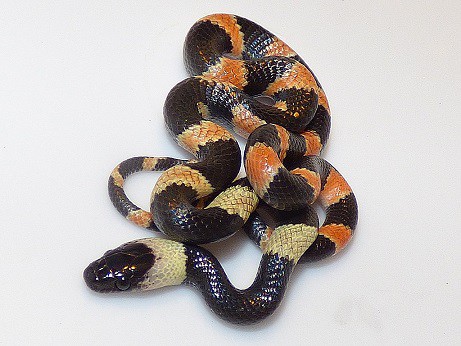
The forest flame snake is a little researched species which nevertheless inhabits a huge swathe of the Americas, ranging from southern Mexico to Paraguay. Sadly, they don’t have the ability to spit fire in your face. Instead, this is a calm and non-threatening snake which inhabits a wide variety of habitats, including dry forest, shrubland and rainforests. Their survival policy seems to be not causing a fuss and hoping that they fly under the radar.
Forest flame snakes (Oxyrhopus petolarius) have no standout feature – hence why nobody has heard of them. They have a very mild venom, which is specialised against Anolis lizards. Bats are another prey, as shown by a Seba’s short-tailed bat which was found in a forest flame snake’s stomach in 2012. The snake measured 82cm, while the bat’s body length was 23cm. The bat had been consumed tail first.
Seba’s short-tailed bat is a frugivorous species which acquires its nutrients from fruit, pollen and nectar. This was the first ever snake species confirmed to eat it, whereas the likes of Jamaican fruit bats already have several confirmed snake predators (including the Cuban boa).
Forest flame snakes average at 100cm, with a record of 132.7cm. They’re nocturnal, and mostly favour the ground, but are able to climb trees if necessary. Locals dub them the false coral snake, after their sharply contrasting stripes, which mimic their venomous neighbours (one of many snakes with that nickname).
| 5 | Checker-bellied snake |
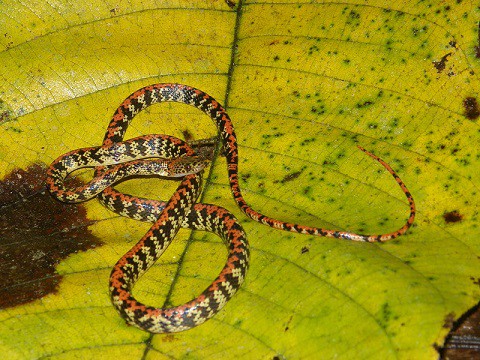
An obscure snake, which is nocturnal and rarely seen by mankind throughout its territory. The checker-bellied snake has been found in scattered spots all over South America, including Peru, Ecuador, Paraguay, Brazil, and also Trinidad and Tobogo.
Checker-bellied snakes (Siphlophis cervinus) mainly hang out in forest edges and misty marshland, and move very strangely. They slither sideways like a desert sidewinder, throwing themselves forward while in a loop formation. Precisely why they move like this is unknown.
The checker-bellied snake is believed to feed on geckos and anoles, but a bat belonging to the Myotis genus was once found in an individual’s stomach. This is an insectivorous group, and the bat had clearly been ingested tail first. Like its fellow bat munchers, this snake is an excellent climber, and they’ve previously been spotted high in coconut palms.
Siphlophis cervinus has an extremely wide head, which is somewhat similar to a viper’s triangular skull. This contrasts against a very thin body, which they’re somehow able to fit an entire bat inside. Adults are 75-125cm long, with a maximum of 1.3 metres. Checker-bellied snakes are an egg-laying species, and typically produce 3-6 per clutch.
| 6 | Yellow-red ratsnake |
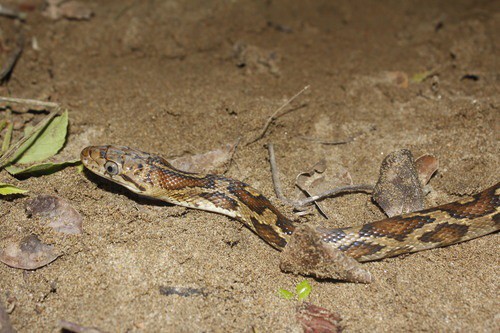
A 125cm constrictor, which is often red and yellow, but also a mixture of grey shades in certain morphs. The yellow-red ratsnake (Pseudelaphe flavirfura) primarily inhabits the Caribbean coast of Central America, in Mexico, Belize, Nicaragua, Honduras and Guatemala. They have a strong tendency to lurk in caves, and have been observed eating many bat species: Mexican greater funnel-eared bats, black-winged little yellow bats, Parnell’s moustached bats, and common vampire bats.
Even though the two species probably diverged before the dinosaur extinction, Pseudelaphe flavirfura has evolved similar bat-hunting tactics to the Cuban boa. They have the skills to fasten their tails to stalactites and dangle down, waiting for flapping bats to pass just after sunset. Yellow-red ratsnakes have the strength to lift the entire upper two thirds of their body while still dangling. Another of their strategies is to venture deeper into caves, into tighter, darker crannies where bats face restrictions to their movements.
The horrific Kantemó Bat Cave of Mexico is home to 70 members of this species, and another of their bases is the Brandon Hill Cave of Honduras. Yellow-red ratsnakes consume their bats headfirst, and can complete swallowing in 9 minutes. In its Mexican heartlands, this species can reach up to 1.85 metres.
| 7 | Amazon tree boa |

A species of numerous forest types. The Amazon tree boa (Corallus hortulana) covers most of South America, and appears in cloudforests, rainforests, and tree clumps near villages alike.
The Amazon tree boa isn’t specially adapted to bats, far from it. But their menu is so enormously wide, their taste buds so undiscerning, that they automatically eat plenty of bats as a consequence. Species they’re known to eat include the Jamaican fruit bat (the Cuban boa’s favourite), black myotis, and dark fruit-eating bat.
Their strategies are also variable. Rather than caves, Amazon tree boas intelligently lurk next to the fruits and flowers that frugivorous bat species acquire their nectar from. They’re also strong climbers, which slither into the thatched roofs of houses and even scientific research stations, and wait patiently for the bats they know will inevitably appear.
The Amazon tree boa’s general strategy is ambush, but they’re more flexible than some boas. They actively forage as well, slithering steadily around the forest while constantly scanning their surroundings. This is a nocturnal species which peaks at 188cm long, which avoids moonlight and has a tendency to investigate small forest streams. Bats being constricted by the Amazon tree boa have even been observed to make distress calls, alerting their fellow kind to the danger.
| 8 | Pygmy python |
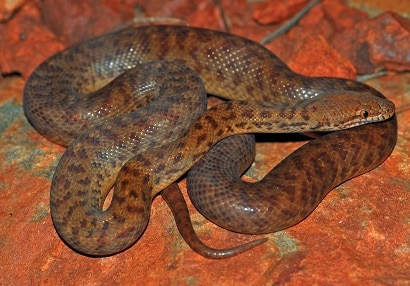
The pygmy python is a harmless, 40cm species living in the Pilbara region of western Australia, which is believed to be the smallest python on Earth. It’s another snake that lurks outside the entrances of dark caves, but rather than humid, mosquito-infested jungles, these are located in the dry, dusty outback. Pilbara is a place of orange as far as the eye can see, but with many hidden caves dotted around, some of which are former gold mines.
Pygmy pythons are less adapted for bat-eating than the Cuban boa. While they wait patiently at cave entrances, they’re unable to dangle precariously from a stalactite. Instead, they wait on ledges, or near rocks, and snap their jaws at the cloud of bats flying from the dark entrance in their hundreds. With a bat seized, they apply their coils, constrict, and swallow, in a manoeuvre they’ve practised dozens of times.
Their close relative the spotted python (Antaresia maculosa) shares these dietary habits. This version lives in Queensland, and is confirmed to hunt the little bent-wing bat, again by waiting outside caves. Mount Etna in Queensland is a particular den, as its sides are littered with hundreds of small caves, making it a hotspot both for spotted pythons and various species of bent-wing bats. Pygmy pythons reach a maximum of just 60cm.
| 9 | Yellow-bellied puffing snake |
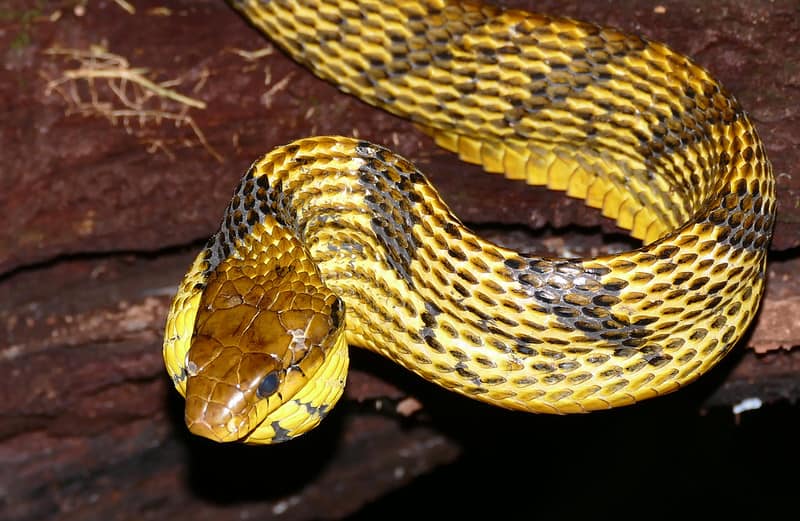
This South American snake somehow combines the length of a hosepipe with being rare and seldom seen. Yellow-bellied puffing snakes average at 2.5 metres, with the largest reaching 3 metres. They range from eastern Ecuador to Brazil’s Atlantic coast, and are one of many South American snakes with very little research conducted.
This is a snake of contrasting yellow and black. Some are a banana yellow, but with other individuals, it’s more of a sulphurous yellow that belongs in a science lab – hence the Latin name of Spilotes sulphureus. This species likes to rest on trees, but isn’t dependent on them like an emerald tree boa. Their signature defensive trick is to rear up and spread their chest scales, so that the yellow underneath becomes far stronger.
One confirmed prey is the little tinamous (a bird species), observed in Ecuador. Bats are another, as observed in the Caxiuanã National Forest of northern Brazil. A yellow-bellied puffing snake was captured on the roof of a house, and inside its stomach, scientists found a velvety free-tailed bat, a species which reaches 10cm long. This was observed on November 22nd 1998, and was the first ever sighting of this snake eating a bat.
| 10 | Puerto Rican boa |
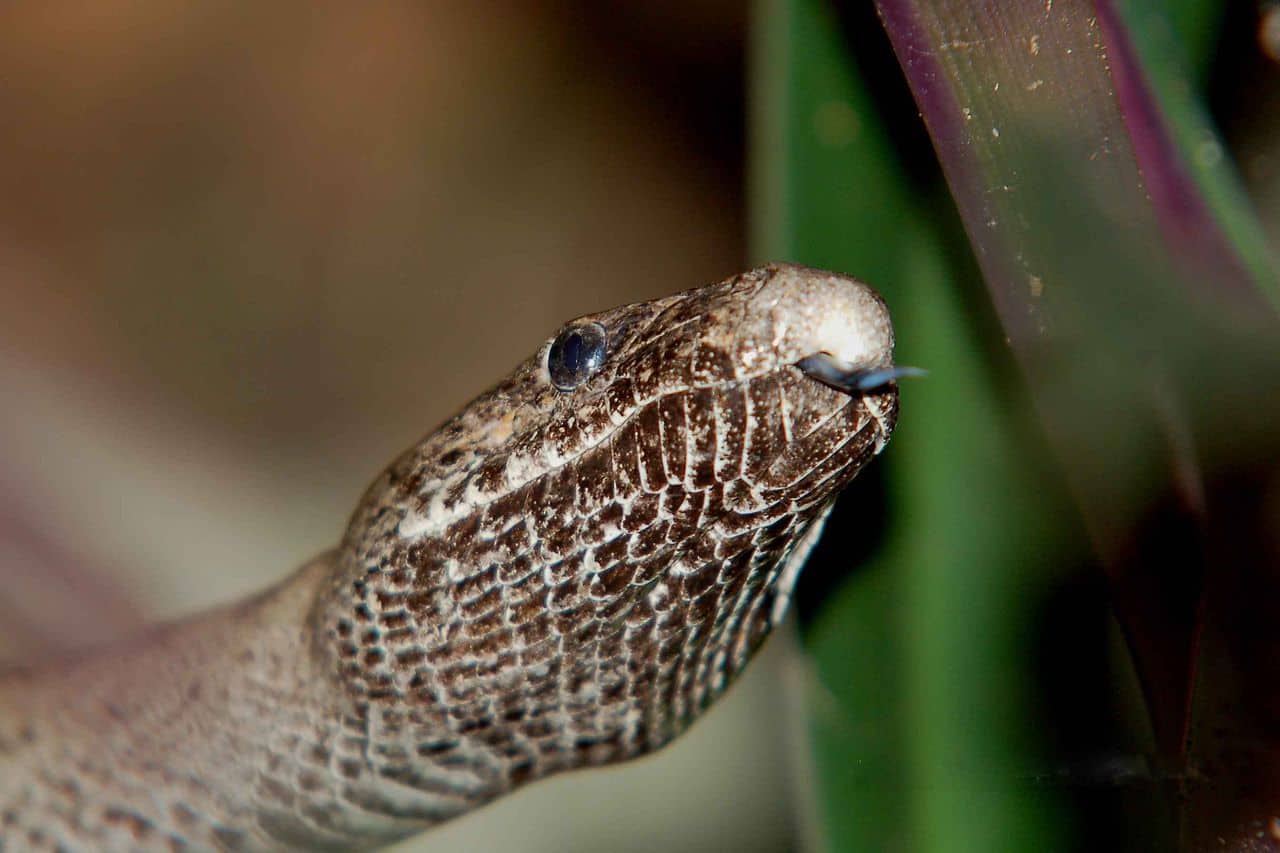
The Puerto Rican boa (Chilabothrus inornatus) belongs to the same genus as the Cuban boa, and its bat-hunting tactics seem to be copy and pasted, despite the fact that they diverged millions of years ago. This species also waits outside caves for the furious flock to emerge, and even times its arrival, entering position 30 minutes before the colony leaves. Thereafter, it’s the usual story: acrobatic dangling, followed by constriction, a session of tricky mid-air rearranging, and finally swallowing.
Puerto Rican boas have such a taste for bats that they’ll fight over them like brown bears duelling for salmon. Two boas were spotted in a cave in a tug of war, pulling the bat with their mouths while intertwining their bodies around each other. Puerto Rican boas have also been observed eating dead bats – specifically, a stiff, dried out buffy flower bat. Another two confirmed prey are the Antillean fruit-eating bat and Leach’s single leaf bat.
While invasive black rats make up 60% of this species’ prey, bats form most of the remainder. Puerto Rican boas measure a hefty 1.8-2 metres, with a maximum of 241cm, but this is shorter than the Cuban boa, which supposedly reached 8 metres in the days of yore before the advent of mass farming.
